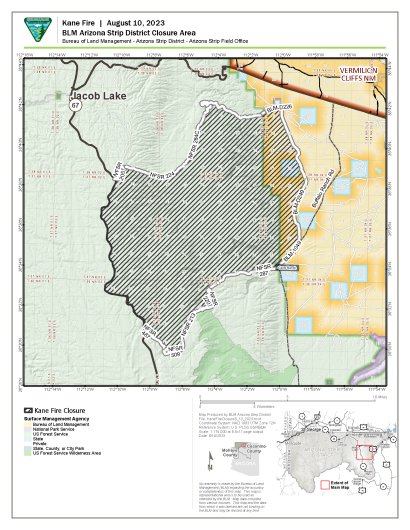BLM Arizona Strip District implements temporary closure for public safety and Kane Fire suppression efforts
Organization:
BLM Office:
Media Contact:
ST. GEORGE, Utah—Due to the extreme fire conditions the Bureau of Land Management (BLM) Arizona Strip District is implementing a temporary closure of BLM-managed lands south of Hwy 89A in House Rock Valley. To support full access for fire resources in continued Kane Fire suppression efforts and to ensure public safety, the closure will begin August 10, 2023, and will continue to the end of the incident.
This temporary closure includes both roads and areas within the boundary described below:
East of Kaibab National Forest, North Kaibab Ranger District
BLM Road D226 from Forest boundary to BLM Road D249
BLM Road D249 south to BLM 1049 (also known as Buffalo Ranch Road or BLM-8910)
BLM Road 1049 (Buffalo Ranch Road) southwest to Forest boundary.
The closure also applies to authorized special recreation permit holders. Private landowners will be allowed access to their property using the most direct route on established roads, and grazing permittees will be allowed access on established roads in the performance of permitted acts.
A detailed map of the closure area is accessible on inciweb.
For Kane Fire updates follow the Southwest Area Incident Management Team:
Inciweb: https://inciweb.nwcg.gov/incident-information/azknf-kane-fire
Facebook: https://www.facebook.com/KaibabNF
Kaibab NF website: https://www.fs.usda.gov/main/kaibab/home
Twitter: https://twitter.com/KaibabNF
Email: [email protected] • Phone: (928) 421-4983 • Office Hours: 8:00am–8:00pm
The BLM manages about 245 million acres of public land located primarily in 12 western states, including Alaska, on behalf of the American people. The BLM also administers 700 million acres of sub-surface mineral estate throughout the nation. Our mission is to sustain the health, diversity, and productivity of America’s public lands for the use and enjoyment of present and future generations.

